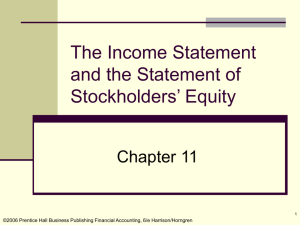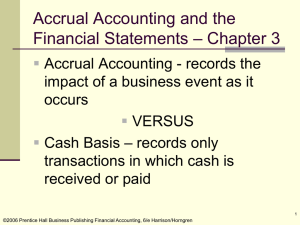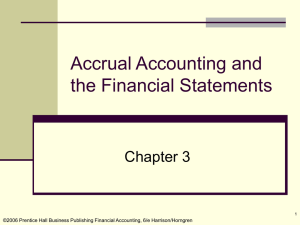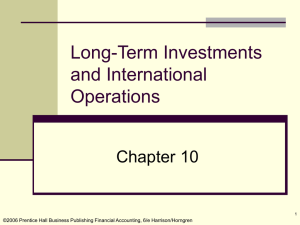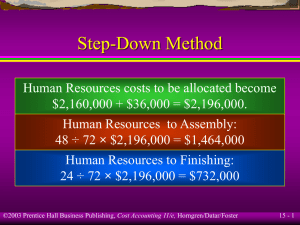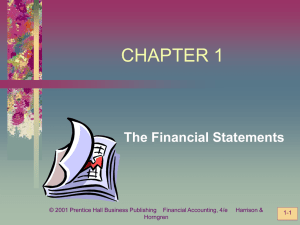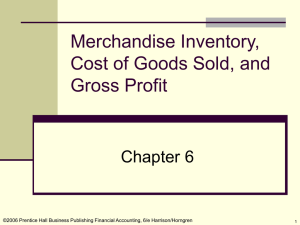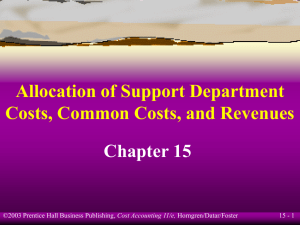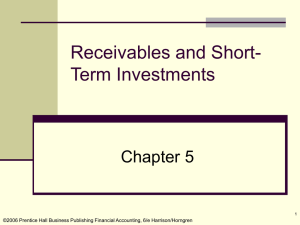Internal Control and Managing Cash
advertisement
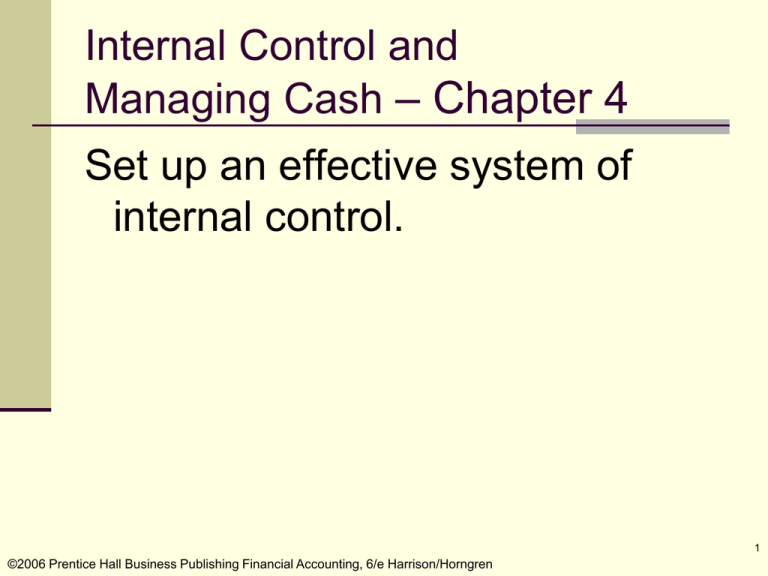
Internal Control and Managing Cash – Chapter 4 Set up an effective system of internal control. 1 ©2006 Prentice Hall Business Publishing Financial Accounting, 6/e Harrison/Horngren Internal Control Organizational plan and all related measures that an entity adopts Safeguard assets Encourage adherence to company policies Promote operational efficiency Ensure accurate and reliable accounting records 2 ©2006 Prentice Hall Business Publishing Financial Accounting, 6/e Harrison/Horngren Components of an Effective System Competent, reliable, and ethical personnel Assignment of responsibilities Proper authorization Separation of duties 3 ©2006 Prentice Hall Business Publishing Financial Accounting, 6/e Harrison/Horngren Audit Examination of company’s financial statements accounting systems, and internal controls, by an outside party Internal auditor - employee of the business External auditor - independent 4 ©2006 Prentice Hall Business Publishing Financial Accounting, 6/e Harrison/Horngren Limitations of Internal Control Collusion - two or more employees working together to defraud the firm A system of internal control that is too complex can hurt efficiency and control 5 ©2006 Prentice Hall Business Publishing Financial Accounting, 6/e Harrison/Horngren The Bank Reconciliation – an internal control device Items that cause differences between bank balance and book balance 1. Items recorded by the company but not yet recorded by the bank: • • Deposits in transit Outstanding checks 6 ©2006 Prentice Hall Business Publishing Financial Accounting, 6/e Harrison/Horngren The Bank Reconciliation Items that cause differences between bank balance and book balance 2. Items on a bank statement and not recorded by the business: • • • • • • Bank collections Electronic funds transfers Service charge Interest revenue earned on account NSF checks Errors 7 ©2006 Prentice Hall Business Publishing Financial Accounting, 6/e Harrison/Horngren Bank Reconciliation Illustrated Business Research, Inc., shows a balance on its bank statement of $5,931.51 on January 31. The company Cash account has a balance of $3,294.21. 1. The January 30 deposit of $1,591.63 does not appear on the bank statement. 2. The bank erroneously charged to the account a $100 check (No. 656) written by Business Research Associates. 8 ©2006 Prentice Hall Business Publishing Financial Accounting, 6/e Harrison/Horngren The Bank Reconciliation Illustrated 3. Five company checks, totaling $1,350.14, issued late in January and recorded in the journal have not been paid by the bank. 4. The bank received $904.03 by EFT on behalf of Business Research, Inc. 5. The bank collected on behalf of the company a note receivable, $2,114 (including interest revenue of $214). 6. The bank statement shows interest revenue of $28.01. 9 ©2006 Prentice Hall Business Publishing Financial Accounting, 6/e Harrison/Horngren The Bank Reconciliation Illustrated 7. Check number 333 for $150 paid to Brown Company on account was recorded as a cash payment of $510. 8. The bank service charge for the month was $14.25. 9. The bank statement shows an NSF check for $52. 10.Business Research pays insurance expense by EFT and has not recorded this $361 payment. 10 ©2006 Prentice Hall Business Publishing Financial Accounting, 6/e Harrison/Horngren The Bank Reconciliation Illustrated Balance per bank, January 31 Add deposit in transit Check erroneously charged Less outstanding checks Adjusted bank balance $5,931.51 1,591.63 100.00 $7,623.14 (1,350.14) $6,273.00 11 ©2006 Prentice Hall Business Publishing Financial Accounting, 6/e Harrison/Horngren The Bank Reconciliation Illustrated Balance per books, January 31 Add: ETF receipt of rent revenue Collection of note receivable Interest revenue earned Correction of book error $3,294.21 904.03 2,114.00 28.01 360.00 $6,700.25 Less: Service charge $ 14.25 NSF check 52.00 Payment of insurance expense 361.00 ( 427.25) Adjusted book balance $6,273.00 12 ©2006 Prentice Hall Business Publishing Financial Accounting, 6/e Harrison/Horngren Cash receipts and cash payments internal controls Petty Cash - A small amount of cash kept on hand to pay for minor expenses. 13 ©2006 Prentice Hall Business Publishing Financial Accounting, 6/e Harrison/Horngren Using a Budget to Manage Cash A financial plan that helps coordinate business activities Cash budget - helps an entity manage cash by planning receipt and payment of cash during a future period 14 ©2006 Prentice Hall Business Publishing Financial Accounting, 6/e Harrison/Horngren Using a Budget to Manage Cash Cash balance, beginning + Budgeted cash receipts - Budgeted cash payments Expected cash balance, ending 15 ©2006 Prentice Hall Business Publishing Financial Accounting, 6/e Harrison/Horngren Reporting Cash on the Balance Sheet Companies usually combine all cash amount into single total called “Cash and Cash Equivalents” on the balance sheet. Cash equivalents include liquid assets Time deposits Certificates of deposit 16 ©2006 Prentice Hall Business Publishing Financial Accounting, 6/e Harrison/Horngren Ethics and Accounting Company code of ethical and responsible behavior by employees AICPA Code of Professional Conduct Standards of Ethical Conduct for Management Accountants 17 ©2006 Prentice Hall Business Publishing Financial Accounting, 6/e Harrison/Horngren
